Dissertation: Cannabis, Morphine in Cancer Pain Management, Derby Uni
VerifiedAdded on 2023/01/19
|51
|12010
|89
Thesis and Dissertation
AI Summary
This dissertation, conducted for a Nursing Studies program at the University of Derby, investigates the effectiveness of cannabis and morphine in managing cancer pain. The study employs a Rapid Evidence Assessment (REA) to compare the benefits and drawbacks of both treatments, addressing the research question: "Does cannabis or morphine result in improved pain management in cancer?" The dissertation includes an abstract, introduction, methods (including search strategy, inclusion/exclusion criteria, and data synthesis), results (summarizing findings from included studies), discussion, and conclusion. It explores the rationale for the research, introduces both cannabis and morphine for pain management, and outlines the aim and objectives. The methods section details the REA design, research question, search strategy, and ethical considerations. The results section presents summaries of included studies, comparing the efficacy and adverse effects of morphine and cannabis. The discussion analyzes the findings, considering the strengths and limitations of each treatment, and offers recommendations for future research. The conclusion summarizes the comparative analysis and highlights the need for further studies to standardize and regulate the use of both morphine and cannabis in cancer pain management. The dissertation includes a glossary of acronyms, a table of contents, and references.
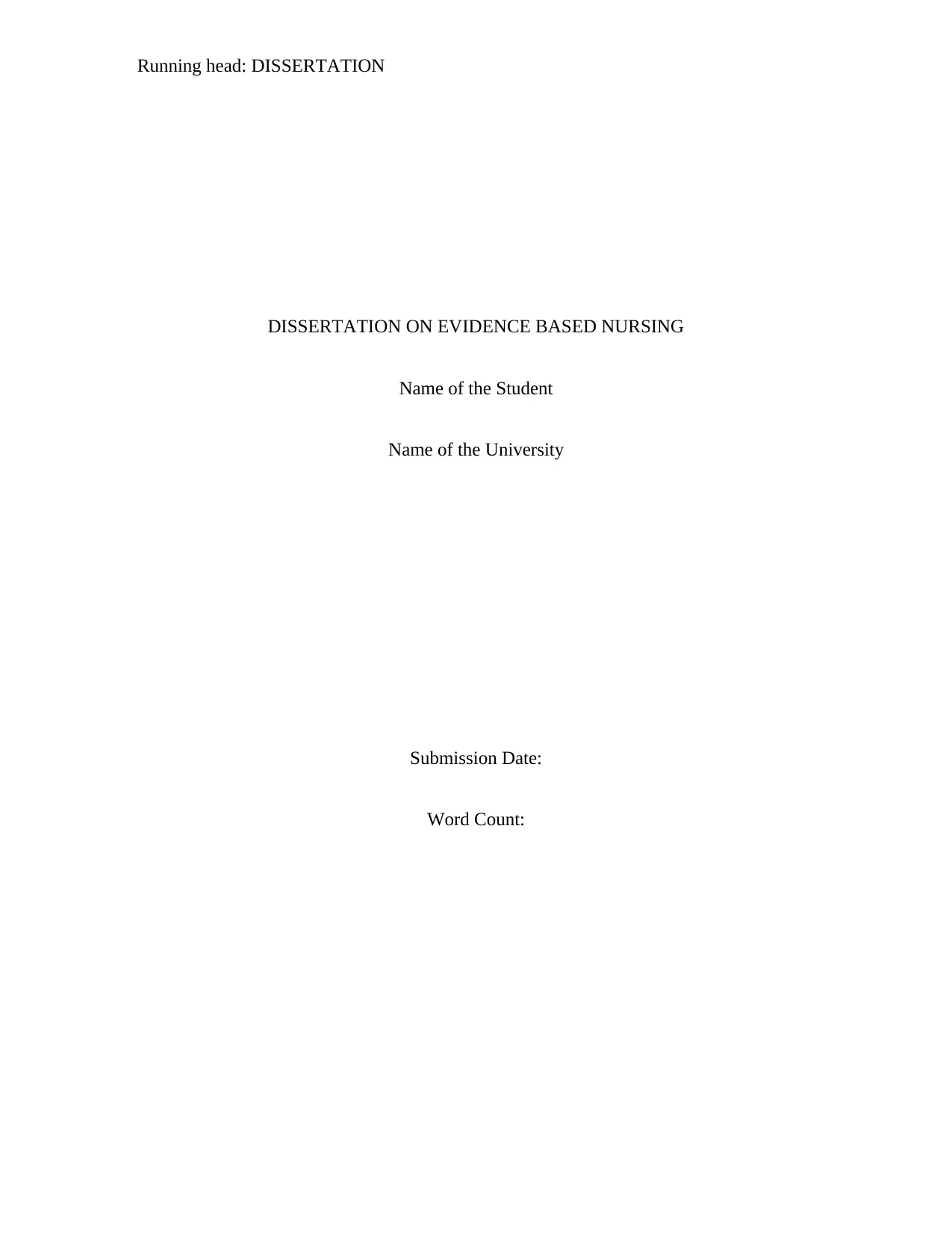
Running head: DISSERTATION
DISSERTATION ON EVIDENCE BASED NURSING
Name of the Student
Name of the University
Submission Date:
Word Count:
DISSERTATION ON EVIDENCE BASED NURSING
Name of the Student
Name of the University
Submission Date:
Word Count:
Paraphrase This Document
Need a fresh take? Get an instant paraphrase of this document with our AI Paraphraser

1DISSERTATION
Investigation of the complementary and alternative medicine’s benefits
in cancer pain management: A comparative study between cannabis and
morphine.
Investigation of the complementary and alternative medicine’s benefits
in cancer pain management: A comparative study between cannabis and
morphine.
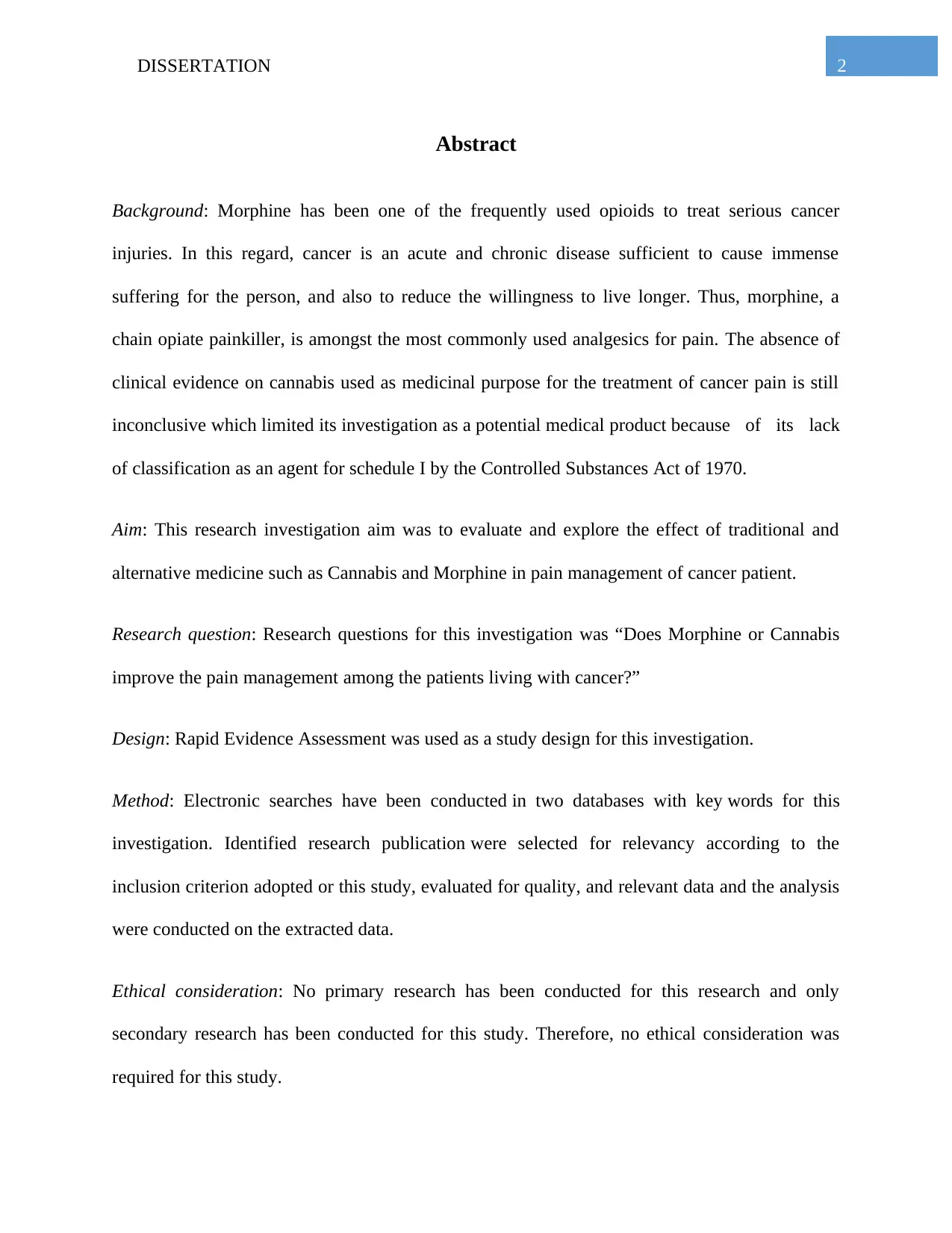
2DISSERTATION
Abstract
Background: Morphine has been one of the frequently used opioids to treat serious cancer
injuries. In this regard, cancer is an acute and chronic disease sufficient to cause immense
suffering for the person, and also to reduce the willingness to live longer. Thus, morphine, a
chain opiate painkiller, is amongst the most commonly used analgesics for pain. The absence of
clinical evidence on cannabis used as medicinal purpose for the treatment of cancer pain is still
inconclusive which limited its investigation as a potential medical product because of its lack
of classification as an agent for schedule I by the Controlled Substances Act of 1970.
Aim: This research investigation aim was to evaluate and explore the effect of traditional and
alternative medicine such as Cannabis and Morphine in pain management of cancer patient.
Research question: Research questions for this investigation was “Does Morphine or Cannabis
improve the pain management among the patients living with cancer?”
Design: Rapid Evidence Assessment was used as a study design for this investigation.
Method: Electronic searches have been conducted in two databases with key words for this
investigation. Identified research publication were selected for relevancy according to the
inclusion criterion adopted or this study, evaluated for quality, and relevant data and the analysis
were conducted on the extracted data.
Ethical consideration: No primary research has been conducted for this research and only
secondary research has been conducted for this study. Therefore, no ethical consideration was
required for this study.
Abstract
Background: Morphine has been one of the frequently used opioids to treat serious cancer
injuries. In this regard, cancer is an acute and chronic disease sufficient to cause immense
suffering for the person, and also to reduce the willingness to live longer. Thus, morphine, a
chain opiate painkiller, is amongst the most commonly used analgesics for pain. The absence of
clinical evidence on cannabis used as medicinal purpose for the treatment of cancer pain is still
inconclusive which limited its investigation as a potential medical product because of its lack
of classification as an agent for schedule I by the Controlled Substances Act of 1970.
Aim: This research investigation aim was to evaluate and explore the effect of traditional and
alternative medicine such as Cannabis and Morphine in pain management of cancer patient.
Research question: Research questions for this investigation was “Does Morphine or Cannabis
improve the pain management among the patients living with cancer?”
Design: Rapid Evidence Assessment was used as a study design for this investigation.
Method: Electronic searches have been conducted in two databases with key words for this
investigation. Identified research publication were selected for relevancy according to the
inclusion criterion adopted or this study, evaluated for quality, and relevant data and the analysis
were conducted on the extracted data.
Ethical consideration: No primary research has been conducted for this research and only
secondary research has been conducted for this study. Therefore, no ethical consideration was
required for this study.
⊘ This is a preview!⊘
Do you want full access?
Subscribe today to unlock all pages.

Trusted by 1+ million students worldwide
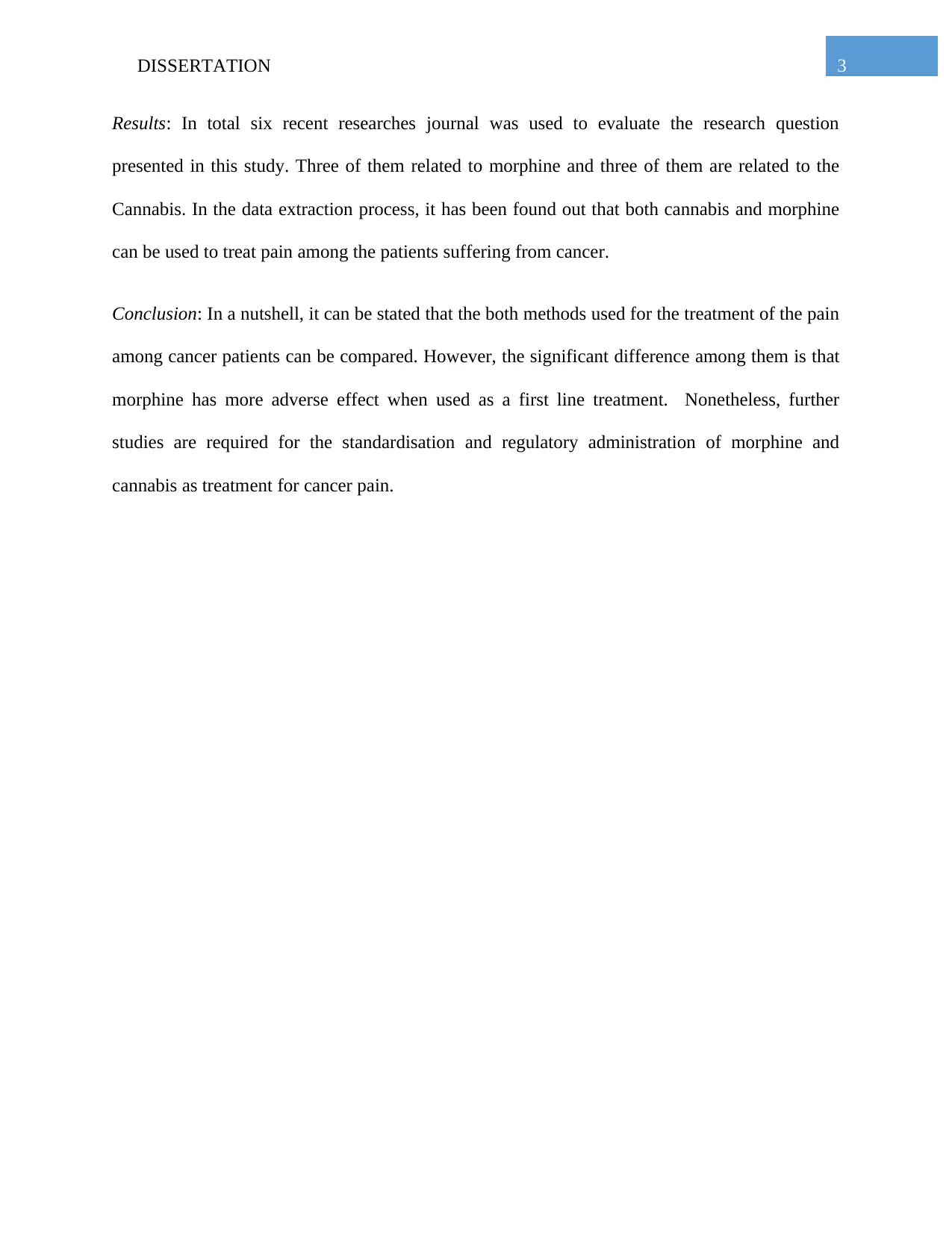
3DISSERTATION
Results: In total six recent researches journal was used to evaluate the research question
presented in this study. Three of them related to morphine and three of them are related to the
Cannabis. In the data extraction process, it has been found out that both cannabis and morphine
can be used to treat pain among the patients suffering from cancer.
Conclusion: In a nutshell, it can be stated that the both methods used for the treatment of the pain
among cancer patients can be compared. However, the significant difference among them is that
morphine has more adverse effect when used as a first line treatment. Nonetheless, further
studies are required for the standardisation and regulatory administration of morphine and
cannabis as treatment for cancer pain.
Results: In total six recent researches journal was used to evaluate the research question
presented in this study. Three of them related to morphine and three of them are related to the
Cannabis. In the data extraction process, it has been found out that both cannabis and morphine
can be used to treat pain among the patients suffering from cancer.
Conclusion: In a nutshell, it can be stated that the both methods used for the treatment of the pain
among cancer patients can be compared. However, the significant difference among them is that
morphine has more adverse effect when used as a first line treatment. Nonetheless, further
studies are required for the standardisation and regulatory administration of morphine and
cannabis as treatment for cancer pain.
Paraphrase This Document
Need a fresh take? Get an instant paraphrase of this document with our AI Paraphraser
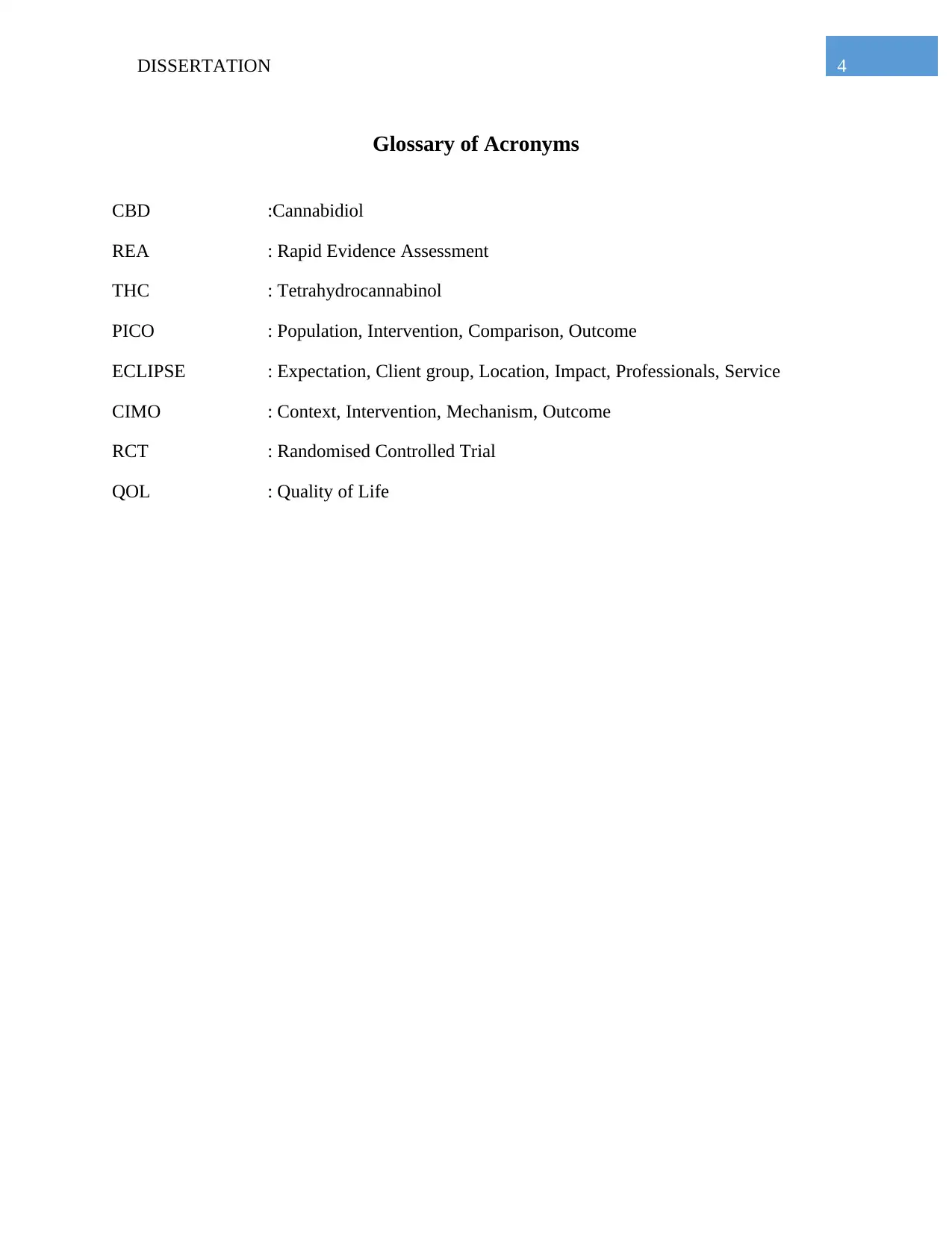
4DISSERTATION
Glossary of Acronyms
CBD :Cannabidiol
REA : Rapid Evidence Assessment
THC : Tetrahydrocannabinol
PICO : Population, Intervention, Comparison, Outcome
ECLIPSE : Expectation, Client group, Location, Impact, Professionals, Service
CIMO : Context, Intervention, Mechanism, Outcome
RCT : Randomised Controlled Trial
QOL : Quality of Life
Glossary of Acronyms
CBD :Cannabidiol
REA : Rapid Evidence Assessment
THC : Tetrahydrocannabinol
PICO : Population, Intervention, Comparison, Outcome
ECLIPSE : Expectation, Client group, Location, Impact, Professionals, Service
CIMO : Context, Intervention, Mechanism, Outcome
RCT : Randomised Controlled Trial
QOL : Quality of Life
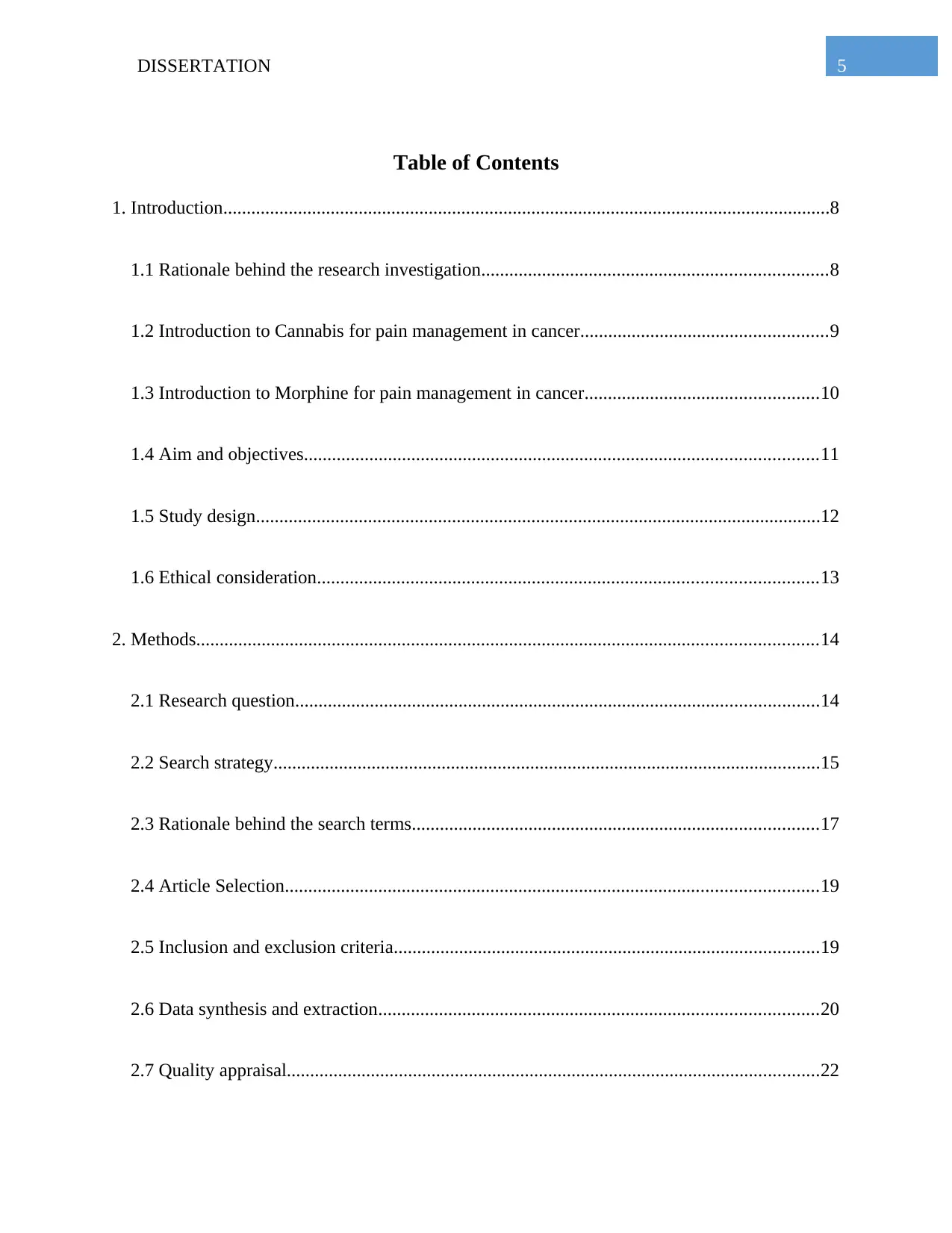
5DISSERTATION
Table of Contents
1. Introduction..................................................................................................................................8
1.1 Rationale behind the research investigation..........................................................................8
1.2 Introduction to Cannabis for pain management in cancer.....................................................9
1.3 Introduction to Morphine for pain management in cancer..................................................10
1.4 Aim and objectives..............................................................................................................11
1.5 Study design.........................................................................................................................12
1.6 Ethical consideration...........................................................................................................13
2. Methods.....................................................................................................................................14
2.1 Research question................................................................................................................14
2.2 Search strategy.....................................................................................................................15
2.3 Rationale behind the search terms.......................................................................................17
2.4 Article Selection..................................................................................................................19
2.5 Inclusion and exclusion criteria...........................................................................................19
2.6 Data synthesis and extraction..............................................................................................20
2.7 Quality appraisal..................................................................................................................22
Table of Contents
1. Introduction..................................................................................................................................8
1.1 Rationale behind the research investigation..........................................................................8
1.2 Introduction to Cannabis for pain management in cancer.....................................................9
1.3 Introduction to Morphine for pain management in cancer..................................................10
1.4 Aim and objectives..............................................................................................................11
1.5 Study design.........................................................................................................................12
1.6 Ethical consideration...........................................................................................................13
2. Methods.....................................................................................................................................14
2.1 Research question................................................................................................................14
2.2 Search strategy.....................................................................................................................15
2.3 Rationale behind the search terms.......................................................................................17
2.4 Article Selection..................................................................................................................19
2.5 Inclusion and exclusion criteria...........................................................................................19
2.6 Data synthesis and extraction..............................................................................................20
2.7 Quality appraisal..................................................................................................................22
⊘ This is a preview!⊘
Do you want full access?
Subscribe today to unlock all pages.

Trusted by 1+ million students worldwide
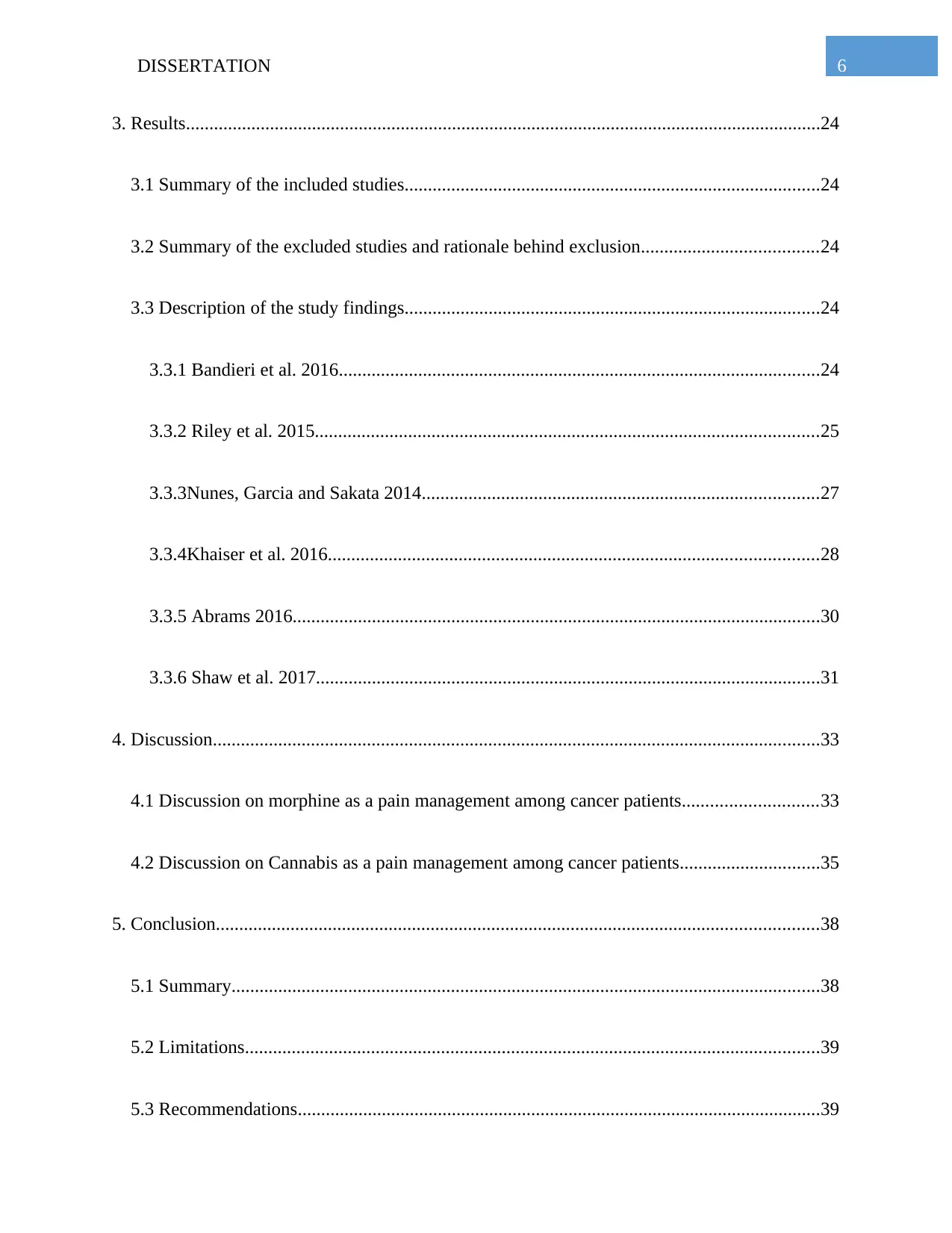
6DISSERTATION
3. Results........................................................................................................................................24
3.1 Summary of the included studies.........................................................................................24
3.2 Summary of the excluded studies and rationale behind exclusion......................................24
3.3 Description of the study findings.........................................................................................24
3.3.1 Bandieri et al. 2016.......................................................................................................24
3.3.2 Riley et al. 2015............................................................................................................25
3.3.3Nunes, Garcia and Sakata 2014.....................................................................................27
3.3.4Khaiser et al. 2016.........................................................................................................28
3.3.5 Abrams 2016.................................................................................................................30
3.3.6 Shaw et al. 2017............................................................................................................31
4. Discussion..................................................................................................................................33
4.1 Discussion on morphine as a pain management among cancer patients.............................33
4.2 Discussion on Cannabis as a pain management among cancer patients..............................35
5. Conclusion.................................................................................................................................38
5.1 Summary..............................................................................................................................38
5.2 Limitations...........................................................................................................................39
5.3 Recommendations................................................................................................................39
3. Results........................................................................................................................................24
3.1 Summary of the included studies.........................................................................................24
3.2 Summary of the excluded studies and rationale behind exclusion......................................24
3.3 Description of the study findings.........................................................................................24
3.3.1 Bandieri et al. 2016.......................................................................................................24
3.3.2 Riley et al. 2015............................................................................................................25
3.3.3Nunes, Garcia and Sakata 2014.....................................................................................27
3.3.4Khaiser et al. 2016.........................................................................................................28
3.3.5 Abrams 2016.................................................................................................................30
3.3.6 Shaw et al. 2017............................................................................................................31
4. Discussion..................................................................................................................................33
4.1 Discussion on morphine as a pain management among cancer patients.............................33
4.2 Discussion on Cannabis as a pain management among cancer patients..............................35
5. Conclusion.................................................................................................................................38
5.1 Summary..............................................................................................................................38
5.2 Limitations...........................................................................................................................39
5.3 Recommendations................................................................................................................39
Paraphrase This Document
Need a fresh take? Get an instant paraphrase of this document with our AI Paraphraser

7DISSERTATION
6. References..................................................................................................................................41
7. Appendices................................................................................................................................47
7.1 Appendix – I: Evidence level..............................................................................................47
7.2 Appendix – II: Evidence hierarchy level.............................................................................48
7.3 Appendix – III: Evidence hierarchy level for qualitative studies........................................49
6. References..................................................................................................................................41
7. Appendices................................................................................................................................47
7.1 Appendix – I: Evidence level..............................................................................................47
7.2 Appendix – II: Evidence hierarchy level.............................................................................48
7.3 Appendix – III: Evidence hierarchy level for qualitative studies........................................49

8DISSERTATION
Chapter 1
1. Introduction
1.1 Rationale behind the research investigation
The adverse impacts of morphine or any opioid derived drugs have been studied several times
over but no sufficient attempts have been made to create alternative medications to substitute the
widely used opioid- based pain relievers even though various adverse impacts of long-term use
are present (Wiffen, Wee and Moore 2016). Morphine, though, has been one of the frequently
used opioids to treat serious cancer injuries. In this regard, cancer is an acute and chronic disease
sufficient to cause immense suffering for the person, and also to reduce the willingness to live
longer. Thus, morphine, a chain opiate painkiller, is amongst the most commonly used analgesics
for pain (Money and Garber 2018). However opioid-based treatment such as the morphine, as
described by Bandieri et al. (2015), is still very tentative and with many discretions used in
clinical exercise, even in the palliative medication field, despite its effectively and efficiently
reducing even severe suffering such as cancer-related suffering. As Wiffen et al. (2017) have
mentioned, the use of morphine can be viewed as a balance act, and many writers and clinics
have even taken into account the use of moral suffering as a compensation between pain relief
and negative impacts (Mercadante et al. 2016). Recent study uses morphine as a synonym for or
marker of imminent mortality and cancer suffering is also a benchmark for a deep existential
illness. In addition, the morphine mode of action is mediated by a receptor binding process,
particularly the CNS Opioid cells. As Mercadante et al. (2015) discusses, morphine mainly
operates on mu- opioid receptors by catalysing a sequence of responses that in turn alter the
Chapter 1
1. Introduction
1.1 Rationale behind the research investigation
The adverse impacts of morphine or any opioid derived drugs have been studied several times
over but no sufficient attempts have been made to create alternative medications to substitute the
widely used opioid- based pain relievers even though various adverse impacts of long-term use
are present (Wiffen, Wee and Moore 2016). Morphine, though, has been one of the frequently
used opioids to treat serious cancer injuries. In this regard, cancer is an acute and chronic disease
sufficient to cause immense suffering for the person, and also to reduce the willingness to live
longer. Thus, morphine, a chain opiate painkiller, is amongst the most commonly used analgesics
for pain (Money and Garber 2018). However opioid-based treatment such as the morphine, as
described by Bandieri et al. (2015), is still very tentative and with many discretions used in
clinical exercise, even in the palliative medication field, despite its effectively and efficiently
reducing even severe suffering such as cancer-related suffering. As Wiffen et al. (2017) have
mentioned, the use of morphine can be viewed as a balance act, and many writers and clinics
have even taken into account the use of moral suffering as a compensation between pain relief
and negative impacts (Mercadante et al. 2016). Recent study uses morphine as a synonym for or
marker of imminent mortality and cancer suffering is also a benchmark for a deep existential
illness. In addition, the morphine mode of action is mediated by a receptor binding process,
particularly the CNS Opioid cells. As Mercadante et al. (2015) discusses, morphine mainly
operates on mu- opioid receptors by catalysing a sequence of responses that in turn alter the
⊘ This is a preview!⊘
Do you want full access?
Subscribe today to unlock all pages.

Trusted by 1+ million students worldwide
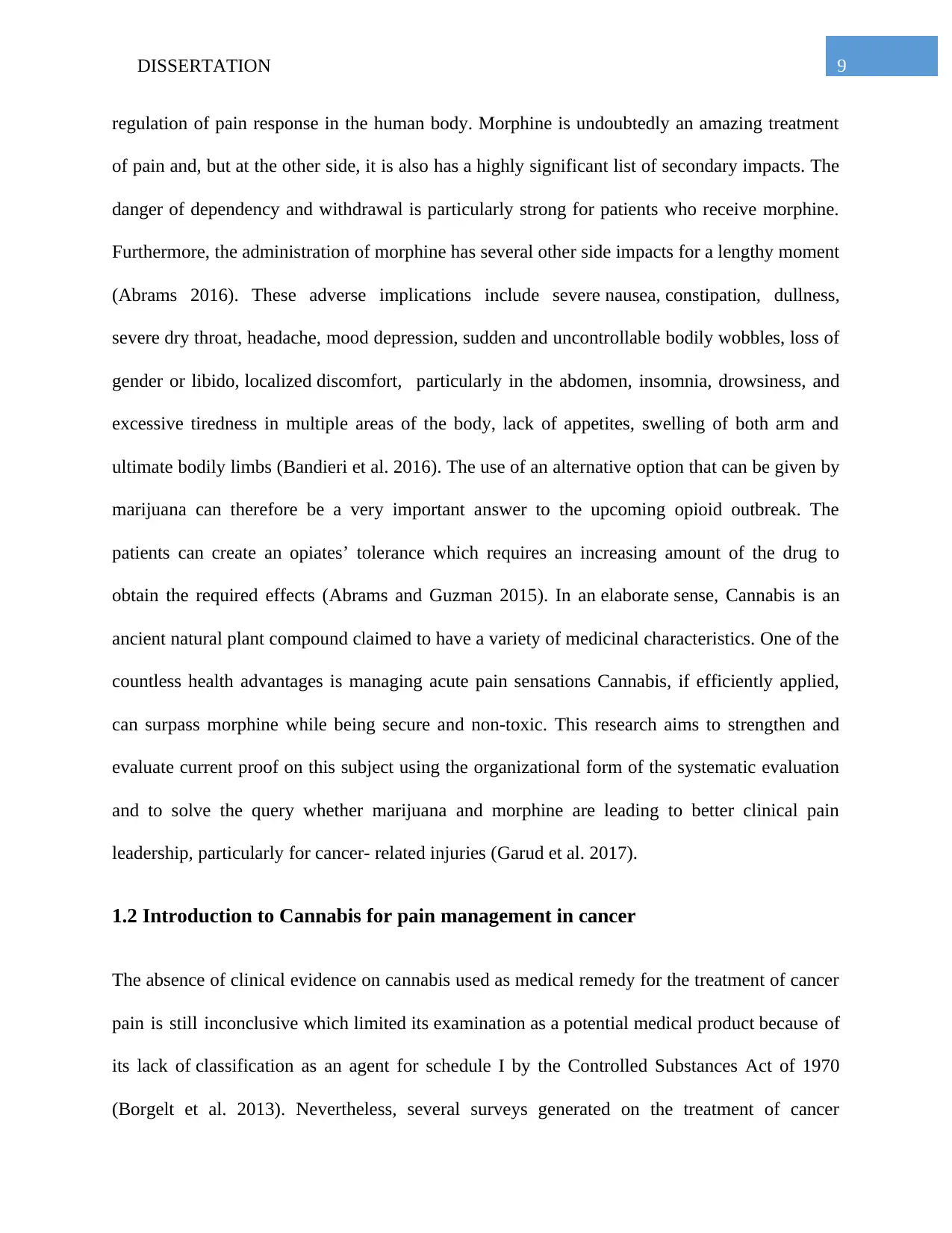
9DISSERTATION
regulation of pain response in the human body. Morphine is undoubtedly an amazing treatment
of pain and, but at the other side, it is also has a highly significant list of secondary impacts. The
danger of dependency and withdrawal is particularly strong for patients who receive morphine.
Furthermore, the administration of morphine has several other side impacts for a lengthy moment
(Abrams 2016). These adverse implications include severe nausea, constipation, dullness,
severe dry throat, headache, mood depression, sudden and uncontrollable bodily wobbles, loss of
gender or libido, localized discomfort, particularly in the abdomen, insomnia, drowsiness, and
excessive tiredness in multiple areas of the body, lack of appetites, swelling of both arm and
ultimate bodily limbs (Bandieri et al. 2016). The use of an alternative option that can be given by
marijuana can therefore be a very important answer to the upcoming opioid outbreak. The
patients can create an opiates’ tolerance which requires an increasing amount of the drug to
obtain the required effects (Abrams and Guzman 2015). In an elaborate sense, Cannabis is an
ancient natural plant compound claimed to have a variety of medicinal characteristics. One of the
countless health advantages is managing acute pain sensations Cannabis, if efficiently applied,
can surpass morphine while being secure and non-toxic. This research aims to strengthen and
evaluate current proof on this subject using the organizational form of the systematic evaluation
and to solve the query whether marijuana and morphine are leading to better clinical pain
leadership, particularly for cancer- related injuries (Garud et al. 2017).
1.2 Introduction to Cannabis for pain management in cancer
The absence of clinical evidence on cannabis used as medical remedy for the treatment of cancer
pain is still inconclusive which limited its examination as a potential medical product because of
its lack of classification as an agent for schedule I by the Controlled Substances Act of 1970
(Borgelt et al. 2013). Nevertheless, several surveys generated on the treatment of cancer
regulation of pain response in the human body. Morphine is undoubtedly an amazing treatment
of pain and, but at the other side, it is also has a highly significant list of secondary impacts. The
danger of dependency and withdrawal is particularly strong for patients who receive morphine.
Furthermore, the administration of morphine has several other side impacts for a lengthy moment
(Abrams 2016). These adverse implications include severe nausea, constipation, dullness,
severe dry throat, headache, mood depression, sudden and uncontrollable bodily wobbles, loss of
gender or libido, localized discomfort, particularly in the abdomen, insomnia, drowsiness, and
excessive tiredness in multiple areas of the body, lack of appetites, swelling of both arm and
ultimate bodily limbs (Bandieri et al. 2016). The use of an alternative option that can be given by
marijuana can therefore be a very important answer to the upcoming opioid outbreak. The
patients can create an opiates’ tolerance which requires an increasing amount of the drug to
obtain the required effects (Abrams and Guzman 2015). In an elaborate sense, Cannabis is an
ancient natural plant compound claimed to have a variety of medicinal characteristics. One of the
countless health advantages is managing acute pain sensations Cannabis, if efficiently applied,
can surpass morphine while being secure and non-toxic. This research aims to strengthen and
evaluate current proof on this subject using the organizational form of the systematic evaluation
and to solve the query whether marijuana and morphine are leading to better clinical pain
leadership, particularly for cancer- related injuries (Garud et al. 2017).
1.2 Introduction to Cannabis for pain management in cancer
The absence of clinical evidence on cannabis used as medical remedy for the treatment of cancer
pain is still inconclusive which limited its examination as a potential medical product because of
its lack of classification as an agent for schedule I by the Controlled Substances Act of 1970
(Borgelt et al. 2013). Nevertheless, several surveys generated on the treatment of cancer
Paraphrase This Document
Need a fresh take? Get an instant paraphrase of this document with our AI Paraphraser
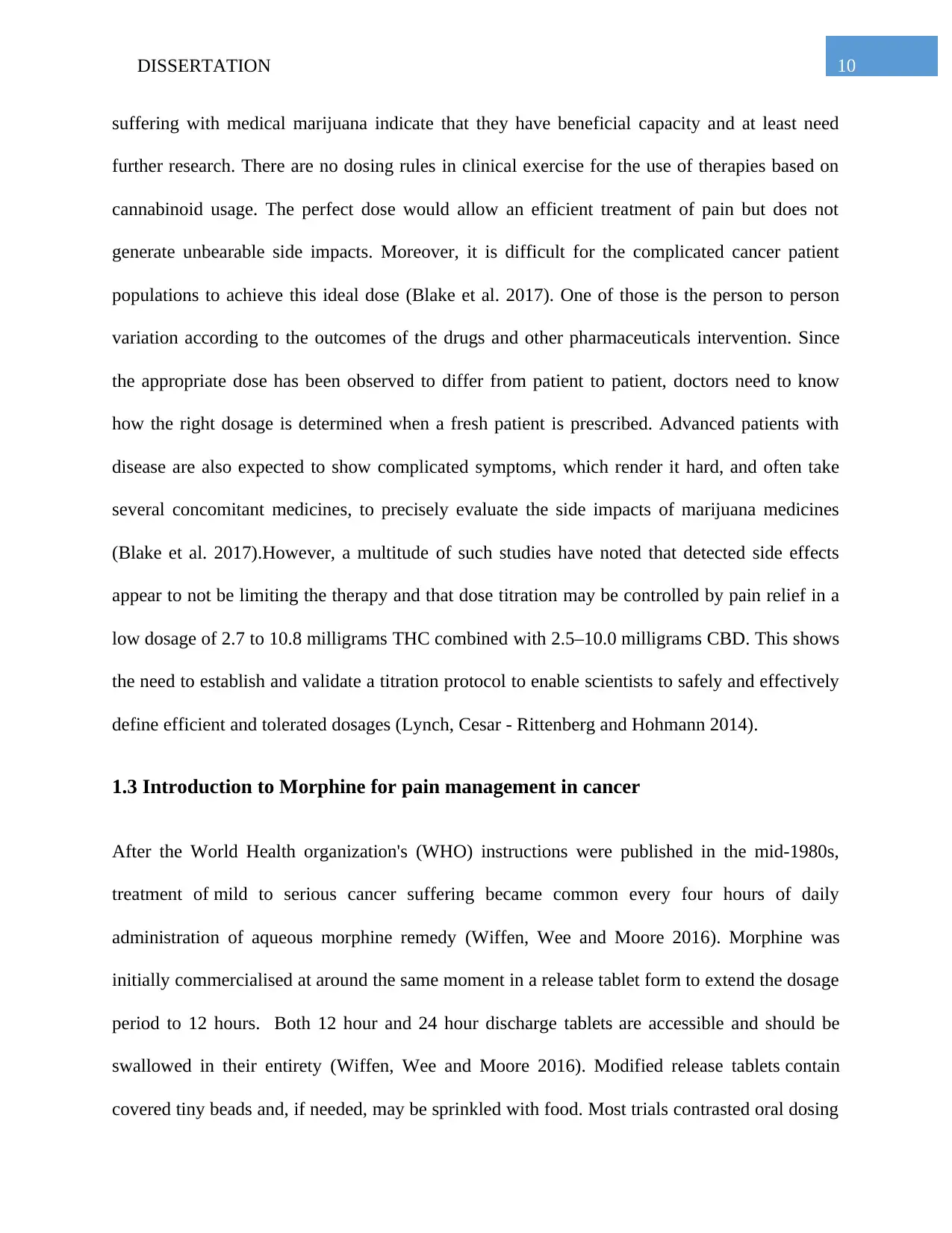
10DISSERTATION
suffering with medical marijuana indicate that they have beneficial capacity and at least need
further research. There are no dosing rules in clinical exercise for the use of therapies based on
cannabinoid usage. The perfect dose would allow an efficient treatment of pain but does not
generate unbearable side impacts. Moreover, it is difficult for the complicated cancer patient
populations to achieve this ideal dose (Blake et al. 2017). One of those is the person to person
variation according to the outcomes of the drugs and other pharmaceuticals intervention. Since
the appropriate dose has been observed to differ from patient to patient, doctors need to know
how the right dosage is determined when a fresh patient is prescribed. Advanced patients with
disease are also expected to show complicated symptoms, which render it hard, and often take
several concomitant medicines, to precisely evaluate the side impacts of marijuana medicines
(Blake et al. 2017).However, a multitude of such studies have noted that detected side effects
appear to not be limiting the therapy and that dose titration may be controlled by pain relief in a
low dosage of 2.7 to 10.8 milligrams THC combined with 2.5–10.0 milligrams CBD. This shows
the need to establish and validate a titration protocol to enable scientists to safely and effectively
define efficient and tolerated dosages (Lynch, Cesar - Rittenberg and Hohmann 2014).
1.3 Introduction to Morphine for pain management in cancer
After the World Health organization's (WHO) instructions were published in the mid-1980s,
treatment of mild to serious cancer suffering became common every four hours of daily
administration of aqueous morphine remedy (Wiffen, Wee and Moore 2016). Morphine was
initially commercialised at around the same moment in a release tablet form to extend the dosage
period to 12 hours. Both 12 hour and 24 hour discharge tablets are accessible and should be
swallowed in their entirety (Wiffen, Wee and Moore 2016). Modified release tablets contain
covered tiny beads and, if needed, may be sprinkled with food. Most trials contrasted oral dosing
suffering with medical marijuana indicate that they have beneficial capacity and at least need
further research. There are no dosing rules in clinical exercise for the use of therapies based on
cannabinoid usage. The perfect dose would allow an efficient treatment of pain but does not
generate unbearable side impacts. Moreover, it is difficult for the complicated cancer patient
populations to achieve this ideal dose (Blake et al. 2017). One of those is the person to person
variation according to the outcomes of the drugs and other pharmaceuticals intervention. Since
the appropriate dose has been observed to differ from patient to patient, doctors need to know
how the right dosage is determined when a fresh patient is prescribed. Advanced patients with
disease are also expected to show complicated symptoms, which render it hard, and often take
several concomitant medicines, to precisely evaluate the side impacts of marijuana medicines
(Blake et al. 2017).However, a multitude of such studies have noted that detected side effects
appear to not be limiting the therapy and that dose titration may be controlled by pain relief in a
low dosage of 2.7 to 10.8 milligrams THC combined with 2.5–10.0 milligrams CBD. This shows
the need to establish and validate a titration protocol to enable scientists to safely and effectively
define efficient and tolerated dosages (Lynch, Cesar - Rittenberg and Hohmann 2014).
1.3 Introduction to Morphine for pain management in cancer
After the World Health organization's (WHO) instructions were published in the mid-1980s,
treatment of mild to serious cancer suffering became common every four hours of daily
administration of aqueous morphine remedy (Wiffen, Wee and Moore 2016). Morphine was
initially commercialised at around the same moment in a release tablet form to extend the dosage
period to 12 hours. Both 12 hour and 24 hour discharge tablets are accessible and should be
swallowed in their entirety (Wiffen, Wee and Moore 2016). Modified release tablets contain
covered tiny beads and, if needed, may be sprinkled with food. Most trials contrasted oral dosing
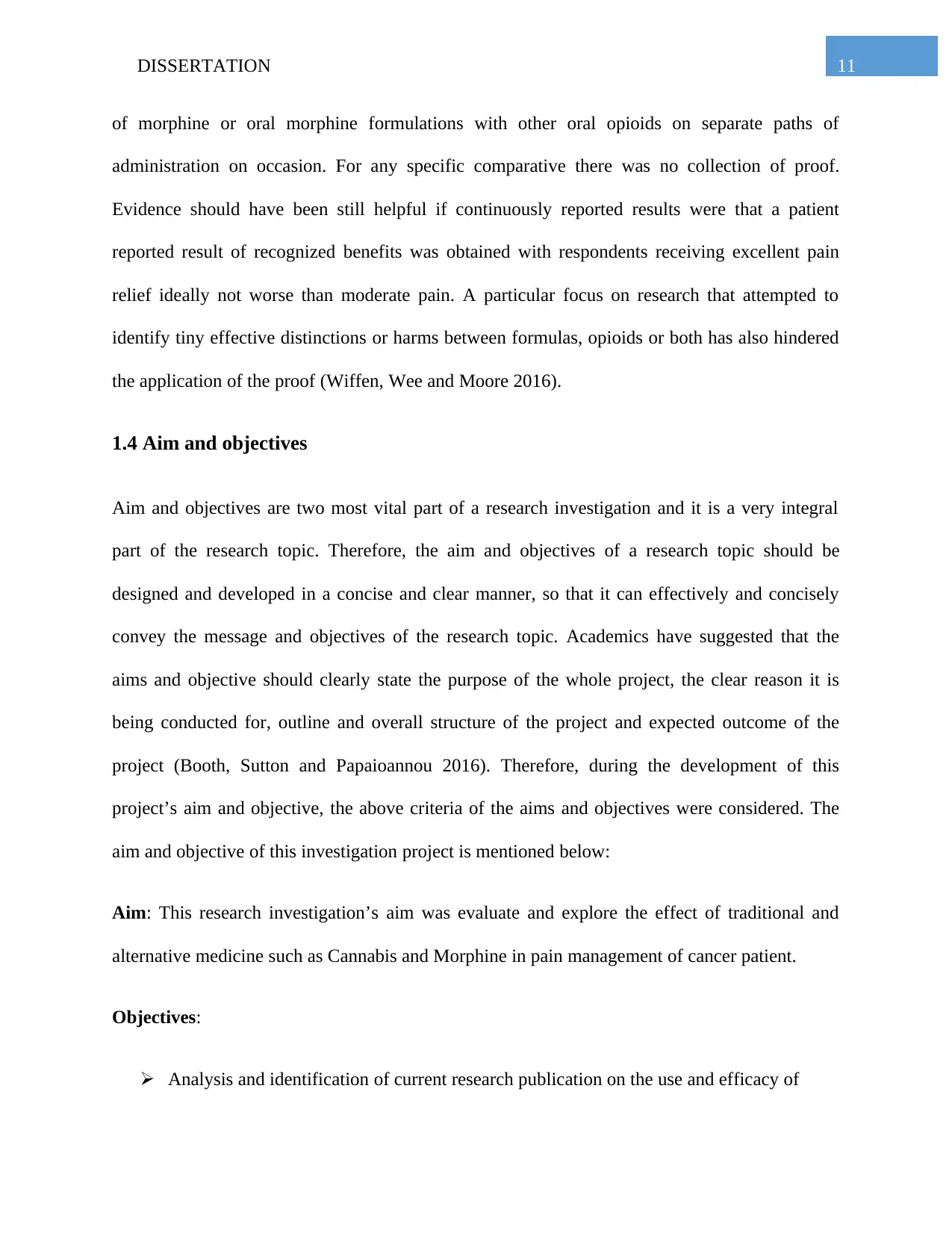
11DISSERTATION
of morphine or oral morphine formulations with other oral opioids on separate paths of
administration on occasion. For any specific comparative there was no collection of proof.
Evidence should have been still helpful if continuously reported results were that a patient
reported result of recognized benefits was obtained with respondents receiving excellent pain
relief ideally not worse than moderate pain. A particular focus on research that attempted to
identify tiny effective distinctions or harms between formulas, opioids or both has also hindered
the application of the proof (Wiffen, Wee and Moore 2016).
1.4 Aim and objectives
Aim and objectives are two most vital part of a research investigation and it is a very integral
part of the research topic. Therefore, the aim and objectives of a research topic should be
designed and developed in a concise and clear manner, so that it can effectively and concisely
convey the message and objectives of the research topic. Academics have suggested that the
aims and objective should clearly state the purpose of the whole project, the clear reason it is
being conducted for, outline and overall structure of the project and expected outcome of the
project (Booth, Sutton and Papaioannou 2016). Therefore, during the development of this
project’s aim and objective, the above criteria of the aims and objectives were considered. The
aim and objective of this investigation project is mentioned below:
Aim: This research investigation’s aim was evaluate and explore the effect of traditional and
alternative medicine such as Cannabis and Morphine in pain management of cancer patient.
Objectives:
Analysis and identification of current research publication on the use and efficacy of
of morphine or oral morphine formulations with other oral opioids on separate paths of
administration on occasion. For any specific comparative there was no collection of proof.
Evidence should have been still helpful if continuously reported results were that a patient
reported result of recognized benefits was obtained with respondents receiving excellent pain
relief ideally not worse than moderate pain. A particular focus on research that attempted to
identify tiny effective distinctions or harms between formulas, opioids or both has also hindered
the application of the proof (Wiffen, Wee and Moore 2016).
1.4 Aim and objectives
Aim and objectives are two most vital part of a research investigation and it is a very integral
part of the research topic. Therefore, the aim and objectives of a research topic should be
designed and developed in a concise and clear manner, so that it can effectively and concisely
convey the message and objectives of the research topic. Academics have suggested that the
aims and objective should clearly state the purpose of the whole project, the clear reason it is
being conducted for, outline and overall structure of the project and expected outcome of the
project (Booth, Sutton and Papaioannou 2016). Therefore, during the development of this
project’s aim and objective, the above criteria of the aims and objectives were considered. The
aim and objective of this investigation project is mentioned below:
Aim: This research investigation’s aim was evaluate and explore the effect of traditional and
alternative medicine such as Cannabis and Morphine in pain management of cancer patient.
Objectives:
Analysis and identification of current research publication on the use and efficacy of
⊘ This is a preview!⊘
Do you want full access?
Subscribe today to unlock all pages.

Trusted by 1+ million students worldwide
1 out of 51
Related Documents
Your All-in-One AI-Powered Toolkit for Academic Success.
+13062052269
info@desklib.com
Available 24*7 on WhatsApp / Email
![[object Object]](/_next/static/media/star-bottom.7253800d.svg)
Unlock your academic potential
Copyright © 2020–2025 A2Z Services. All Rights Reserved. Developed and managed by ZUCOL.





